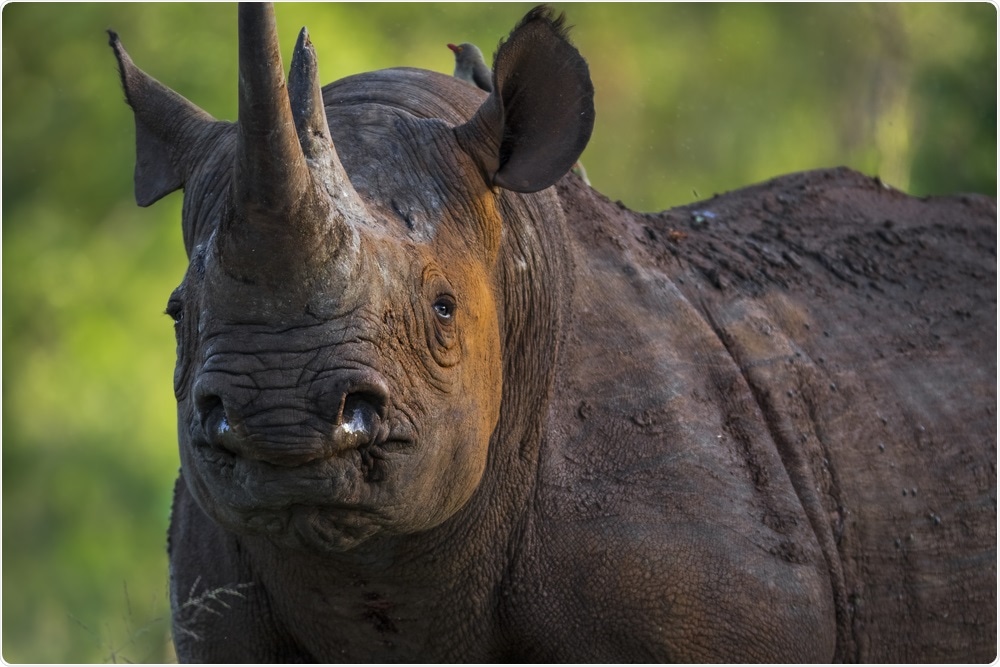New research has revealed that a huge number of mammalian species may have been lost to extinction due to the advent of humans. This finding was based on fossil records unearthed by scientists. The new study titled, "The past and future human impact on mammalian diversity," is published in the latest issue of the journal Science Advances.

Black Rhino in the bush of Kruger National Park. The species overall is classified as critically endangered. Image Credit: Bigger Pixel Photography / Shutterstock
The team of researchers writes that there are at present around 5,700 species of mammals, and since the Late Pleistocene age 126 thousand years, at least 351 mammal species have become extinct. This finding is confirmed by way of historical reports as well as fossil or zooarcheological records, they wrote.
The team writes that there is a rising trend of mammalian species extinctions in the recent past, and this is seen among other groups of animals as well, such as "birds, reptiles, amphibians, and ray-finned fishes." This has led scientists around the world to declare a "biodiversity crisis" and necessitated this type of study. For this study, the team wanted to see the past rates and trends of extinctions with those that took place in recent times.
Are humans responsible?
The team writes that there have been debates over the recent decades saying humans could be the reason behind these extinctions. The authors wrote, "Several studies have identified humans as the main driver of species extinctions since the beginning of the Late Pleistocene." They added that with the arrival of humans, many species went extinct, and this could be a significant temporal association.
For the study, the team took into consideration past extinctions as well as the recent ones and looked at the effect "anthropogenically elevated extinction rates will have on future mammalian diversity."
What was done?
The researchers gathered all the data on the 351 mammal species that became extinct since the beginning of the Late Pleistocene from the PHYLACINE 1.2 database. They counted 2020 as t0 and counted backward in time so that t520= year 1500 CE.
All mammalian fossil records were gathered from the Paleobiology Database, the New and Old Worlds database of fossil mammals, the Neotoma database, and the Sahul database. Next, the team divided their findings into taxonomic subsets of the global mammal data, where they divided mammals into 29 mammalian orders present between the late Pleistocene and today.
As a next step, they compiled data on changes in human population size throughout the past 126,000 years and looked at its association with mammal extinctions. This data they obtained from the HYDE database for Africa, Europe, North America, South America, Asia, and Australia from the year 10,000 BCE until today. They also analyzed the land occupation by humans over the years. After this, they projected the future of the existing species based on the relations derived from the past.
What was found?
The results revealed that the human population size was a direct predictor of past extinctions with an accuracy rate of 96 percent. They noted that climate change had a minimal impact on global mammal extinctions.
The authors wrote, "The 351 global mammal species extinctions that have occurred since the beginning of the Late Pleistocene would occur within only 810 years". They pointed out the there was a significant increase in extinctions during four periods of time:
- Between 63,800 and 32,200 years ago
- Between 16,000 and 9,500 years ago
- Between 2,300 and 600 years ago
- Between 180 and 120 years ago
Applying statistical modeling, the team also found the possible associated factors with the extinctions. These were:
- Human population size - predicted extinctions rate with 96 percent accuracy
- Human land occupation ("total area occupied by humans, including all major landmasses and islands") – predicted extinctions with 97.1 percent accuracy
- Global temperature – predicted extinctions with 63.6 percent accuracy
- Rate of temperature change - extinctions with 60.2 percent accuracy
Based on the mathematical modeling, the team predicted that by the year 2100, 558 mammalian species (anywhere between 502 and 610) would have been extinct. They write they expect a, "5- to 35-fold more simulated extinctions than what would be expected based on current extinction rates estimated from past extinctions."
Conclusions and implications
The authors wrote in conclusion that humans are the main drivers of mammalian species extinction. They wrote, "We are losing biodiversity every year, and with every extinct species and population, we lose unique evolutionary history." They predict a second wave of anthropogenic extinctions by the year 2100.
Tobias Andermann, the corresponding author of the study from Gothenburg Global Biodiversity Centre and the University of Gothenburg, said that thousands of species could still be saved. He added, "Time is pressing...With every lost species, we irreversibly lose a unique portion of Earth's natural history."
The authors signed off, "We hope that our alarming predictions will foster increased realization on the urgency and scale of the conservation efforts needed to safeguard the future of mammalian diversity."
Journal reference:
- The past and future human impact on mammalian diversity, Tobias Andermann, Søren Faurby, Samuel T. Turvey, Alexandre Antonelli, and Daniele Silvestro, Science Advances 04 Sep 2020: Vol. 6, no. 36, eabb2313, DOI: 10.1126/sciadv.abb2313, https://advances.sciencemag.org/content/6/36/eabb2313